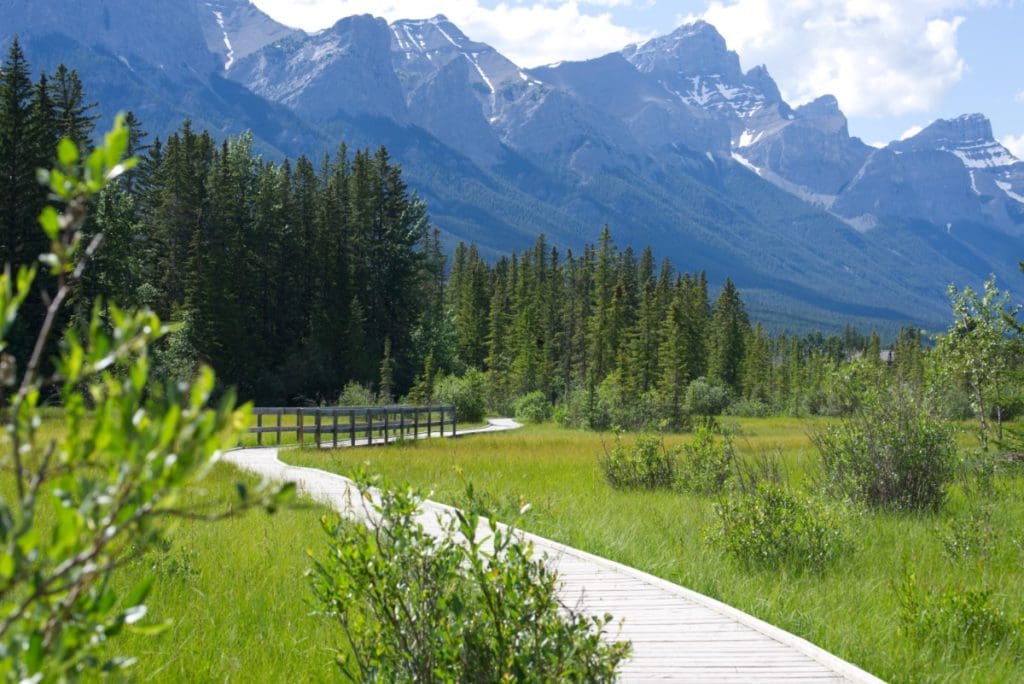While in an Edmonton bookstore, I happened upon a second-hand copy of Bruce Bagemihl’s tome, Biological Exuberance: Animal Homosexuality and Natural Diversity.
The heteronormative view of nature is so pervasive even today that many of us (myself included) remain oblivious to the immense sexual and gender diversity that exists all around us when we head outdoors. And yet, as Bagemihl outlined in his introduction:
“The world is, indeed, teeming with homosexual, bisexual, and transgendered creatures of every stripe and feather. From the southeastern blueberry bee of the United States to more than 130 different bird species worldwide, the ‘birds and the bees,’ literally, are queer.1 “
Bruce Bagemihl, Biological Exuberance: Animal Homosexuality and Natural Diversity
It can be problematic to try to equate human and animal experiences, or to suggest that the presence of a particular behavior in another species justifies that same behavior in humans (eating one’s offspring, is one example that springs to mind).
But talking about sexual diversity in an ecological context does two important services. Mainly, it counters the damaging belief that homosexuality is unnatural, while also enhancing our understanding of the complex landscapes in which we live.
So, with Bagemihl’s expansive work weighing down my backpack, I took a camping trip in the Eastern Slopes of the Canadian Rockies to reconsider my own perspectives.
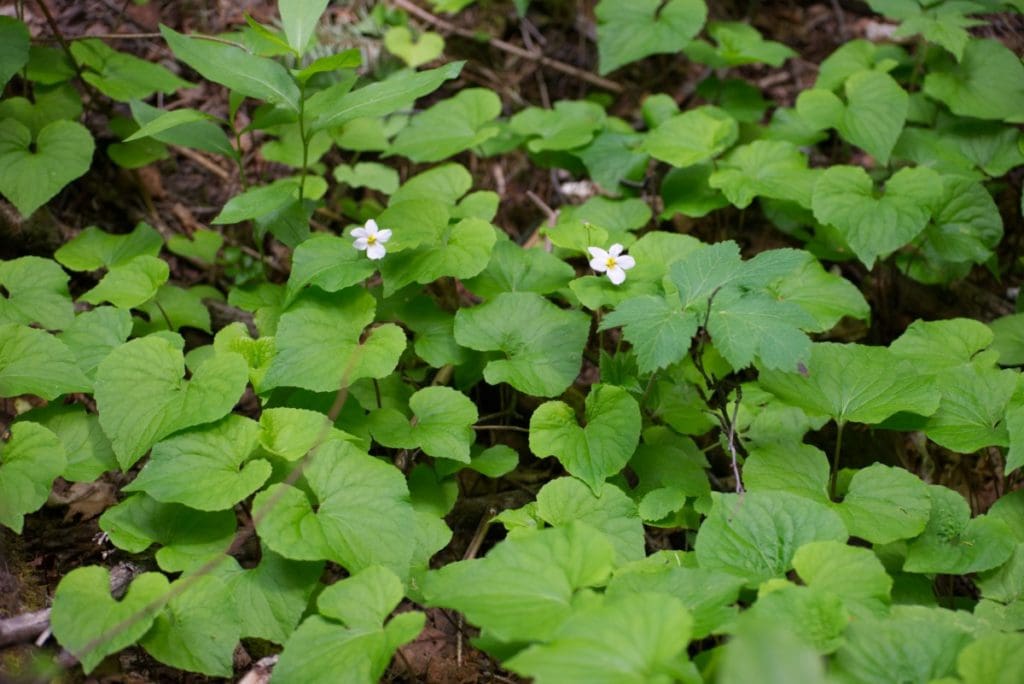
My first find, on the Heart Creek Interpretive Trail in Kananaskis Country, was a symbolic one.
A blanket of Canada violets, delicate white flowers interspersed with heart-shaped leaves, thrived under the shelter of the evergreens. The violet has been a symbol of lesbianism since Greek poet Sappho referenced the flowers in her works about love between women around 600 BC.
As I walked along the rocky trail, it seemed strange to me that that some of us humans ever managed to convince ourselves that nature is not sexually diverse. Those trembling aspens near the beginning of the hike? They typically reproduce asexually, popping up new clone stems that are connected to one root system.
And the brown mushrooms I saw on the forest floor are not simply male or female but have many “mating types” (sometimes numbering in the thousands.) 2 All abundant proof of nature’s complexity and diversity.
From Heart Creek, I ventured west into Banff National Park and headed to the Cave and Basin National Historic Site. I knew I would find creatures at the thermal springs here that did not exactly fit the heterosexual norm, but I’d have to look very closely to spot them.
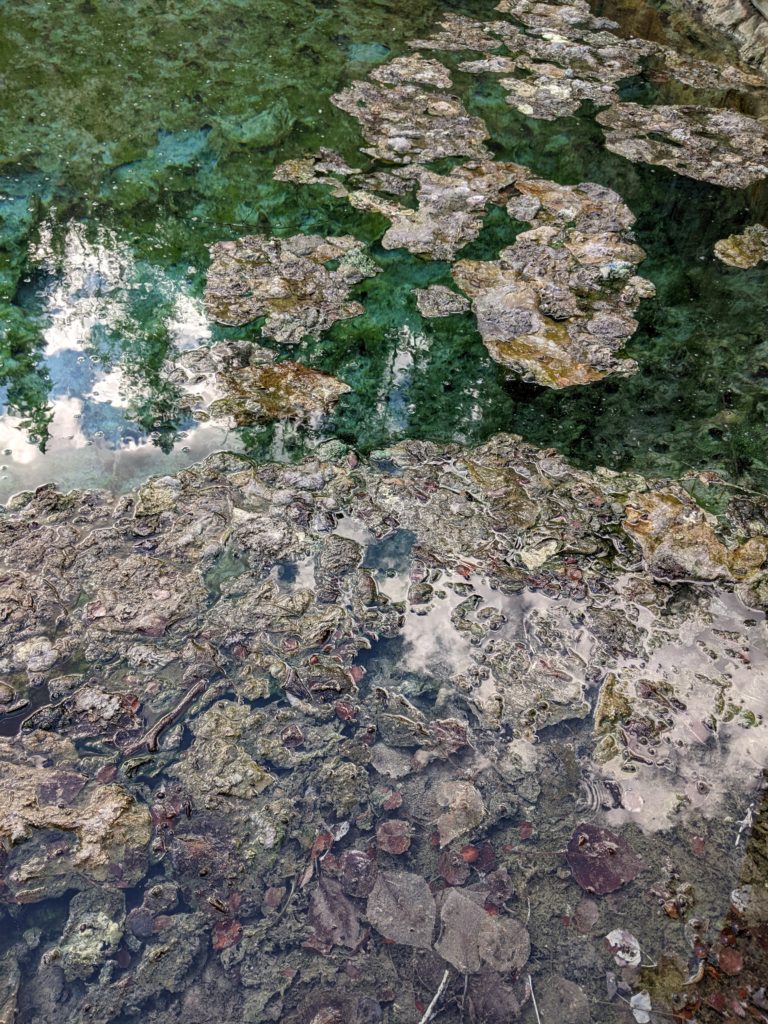
Found nowhere else in the world, the Banff Springs snail (Physella johnsoni) is a freshwater mollusk and the most endangered species in the park.
A Parks Canada staff member kindly pointed out the tiny, well-camouflaged gastropods clinging to microbial mats floating on the surface of the sulphurous ponds.
Like most snails, the Banff Springs snails are hermaphrodites. They have both male and female sex organs, which means they can reproduce with any other member of their species and can even reproduce without a mate.
Snail expert Dr. Dwayne Lepitzki pointed out that “Scientists have found that when snails reproduce on their own, their offspring are not as fit or healthy as are those offspring which have two parents.3 ”
While the ability to self-reproduce might sound like a useful survival quality, it is somewhat of a problem for these rare snails.
I knew that during my short camping trip I would be unlikely to see many of the species identified in Bagemihl’s book where homosexual behaviour (and sometimes same-sex parenting) has been occasionally or regularly observed.
These species include bears, bison, caribou, elk, moose, marmots, foxes and wolves, as well as numerous bird species from Canada geese to tree swallows. I was confident, however, that I’d encounter at least a couple of creatures larger than snails.
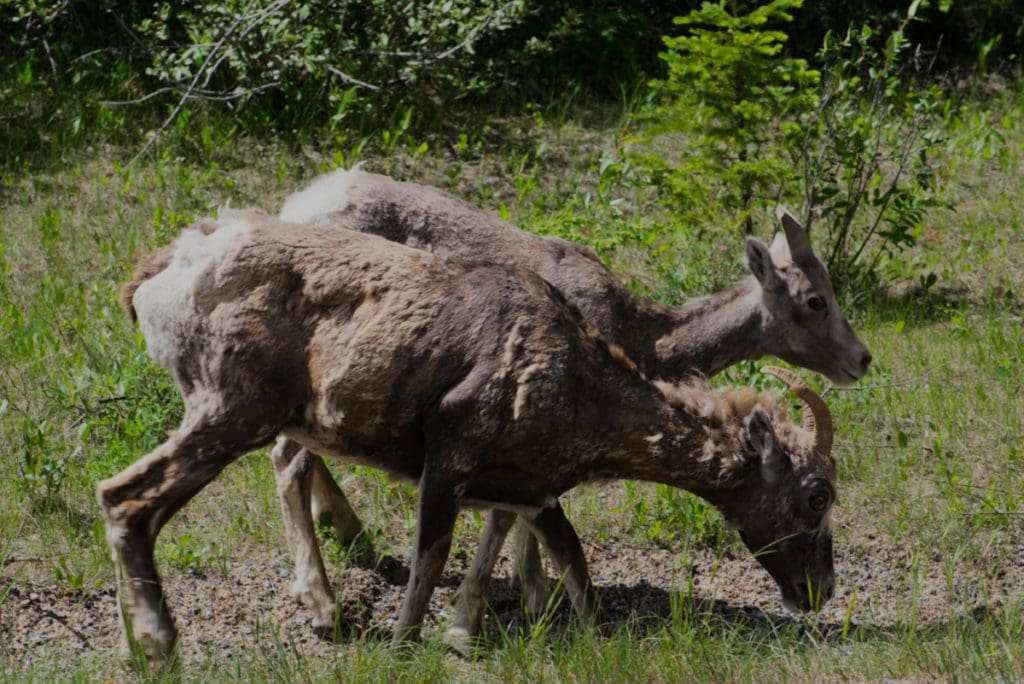
Sure enough, I spot three female Rocky Mountain bighorn sheep grazing near Lake Minnewanka. While homosexual behaviour has been observed in both male and female sheep, it is far more common among males.
Bagemihl wrote that “males live in what one zoologist has described as ‘homosexual societies’ where same-sex courtship and sexual activity occur routinely among all rams.4 ”
While males and females live separately for most of the year, homosexual sex remains very common during the rutting season, and females are known to imitate males to get their attention.
Bagemihl also noted the presence of some transgendered animals in bighorn populations that have the physical characteristics of rams, but the behavioral characteristics of ewes. These animals remain with the ewe herds.
Later that day walking through the ruins of the old townsite at nearby Bankhead, I spotted another ungulate. As I followed the trail, blackened by coal dust from the former mining operation, a young male deer kept a close eye on me through the trees.
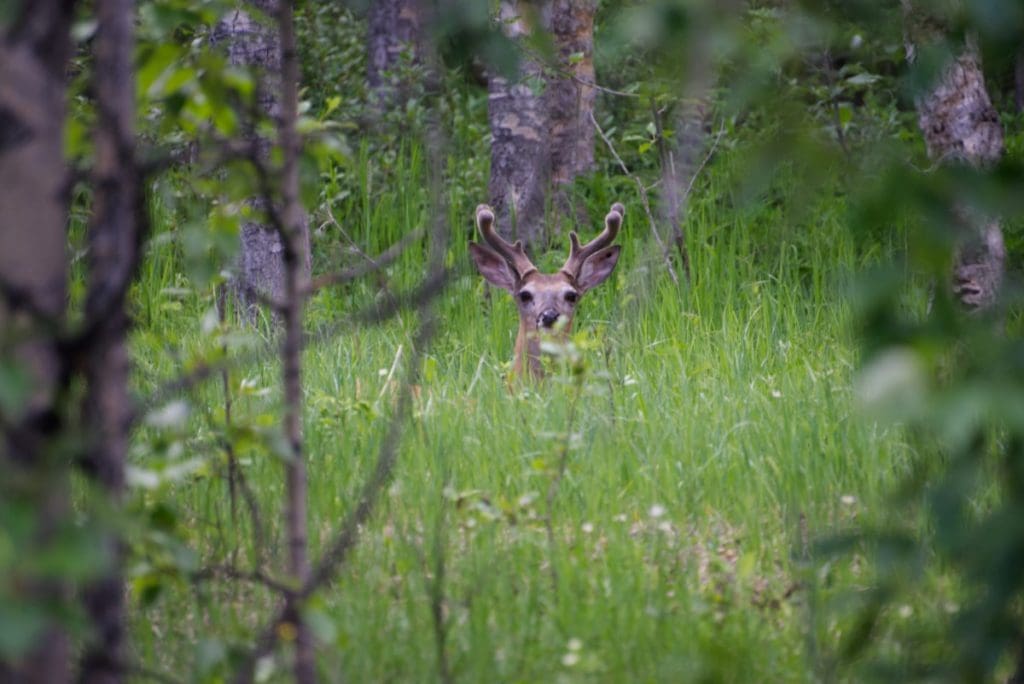
According to Bagemihl, deer are not as inclusive as bighorns when it comes to integrating transgendered members of their population.
Transgendered white-tailed deer (known as “velvet-horns” due to the velvet covering on their antlers that most males shed) live in their own small groups and “are often harassed and attacked by other deer.5 ”
Velvet-horns have some female characteristics and are often similar in size to does.
Other species I spotted on my camping trip in the mountains included mallard ducks, diving underwater to find food in a Canmore creek, and red squirrels scuttling across tree limbs.
Bagemihl wrote about bisexuality in mallards: “females may participate in homosexual copulations while paired with a male, and both sexes may form seasonal homosexual attachments prior to or following a period of heterosexual mating.6 “
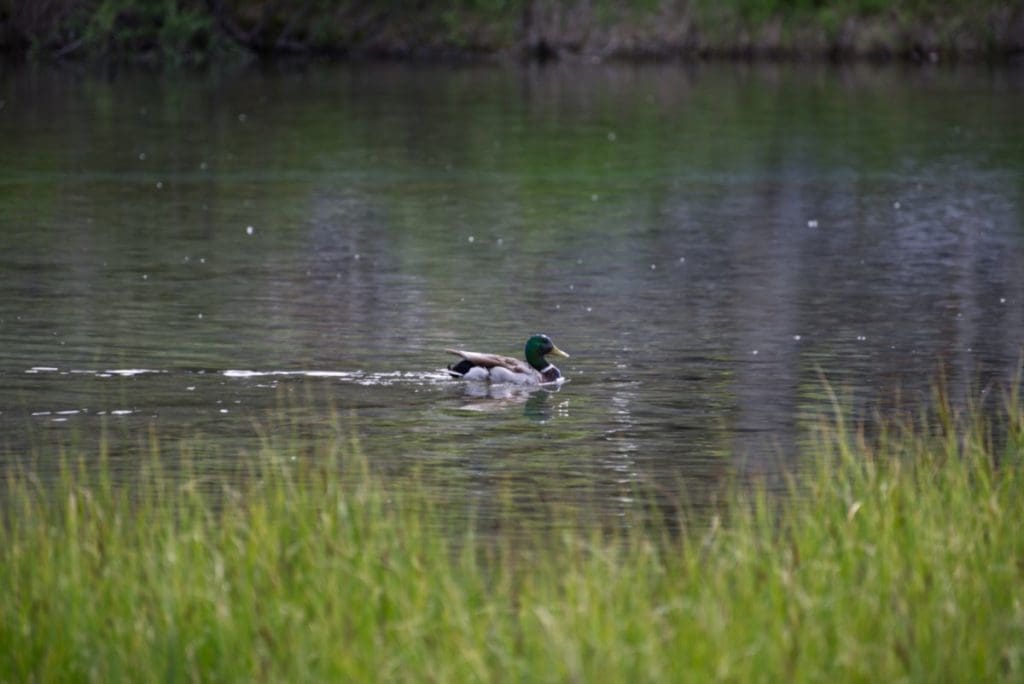
As for the red squirrels, he noted that homosexual relations among the rodents are common for males and females, and females sometimes also co-parent offspring.7
My Rockies adventure taught me to take time to appreciate the wonderful diversity in nature. I thought back to where my journey began, on the Heart Creek Interpretive Trail, where the land was dramatically altered by the 2013 flood.
In one spot, long roots dangled from a low cliff where the soil had been washed away. Life on top of the cliff was thriving. In our ever-changing landscapes, adaptation, and therefore diversity, is not a threat. It is strength, and survival.
Footnotes and citations:
1 Bagemihl, Bruce, Biological Exuberance: Animal Homosexuality and Natural Diversity (New York: St. Martin’s Press, 1999), p. 9.
2 Peris D, Lu DS, Kinneberg VB, Methlie I-S, Dahl MS, James TY, et al., Large-scale fungal strain sequencing unravels the molecular diversity in mating loci maintained by long-term balancing selection, PLOS Genetics 18, 3 (March 2022)
3 Lepitzki, Dwayne, Banff Springs Snails, Bow Valley Naturalists
4 Bagemihl, Biological Exuberance, p. 406
5 Bagemihl, Biological Exuberance, p. 380
6 Bagemihl, Biological Exuberance, p. 493
7 Bagemihl, Biological Exuberance, p. 462
This article was written by Josephine Boxwell. Josephine is one of Y2Y’s 2022 story gatherers. These four unique people are sharing personal stories, memories and places related to the special landscapes of Alberta’s Eastern Slopes, often perspectives that are underrepresented in mainstream media. Read other stories in this series.
We are grateful for the financial support provided by Alberta Ecotrust and The Calgary Foundation for our story gatherer series.
